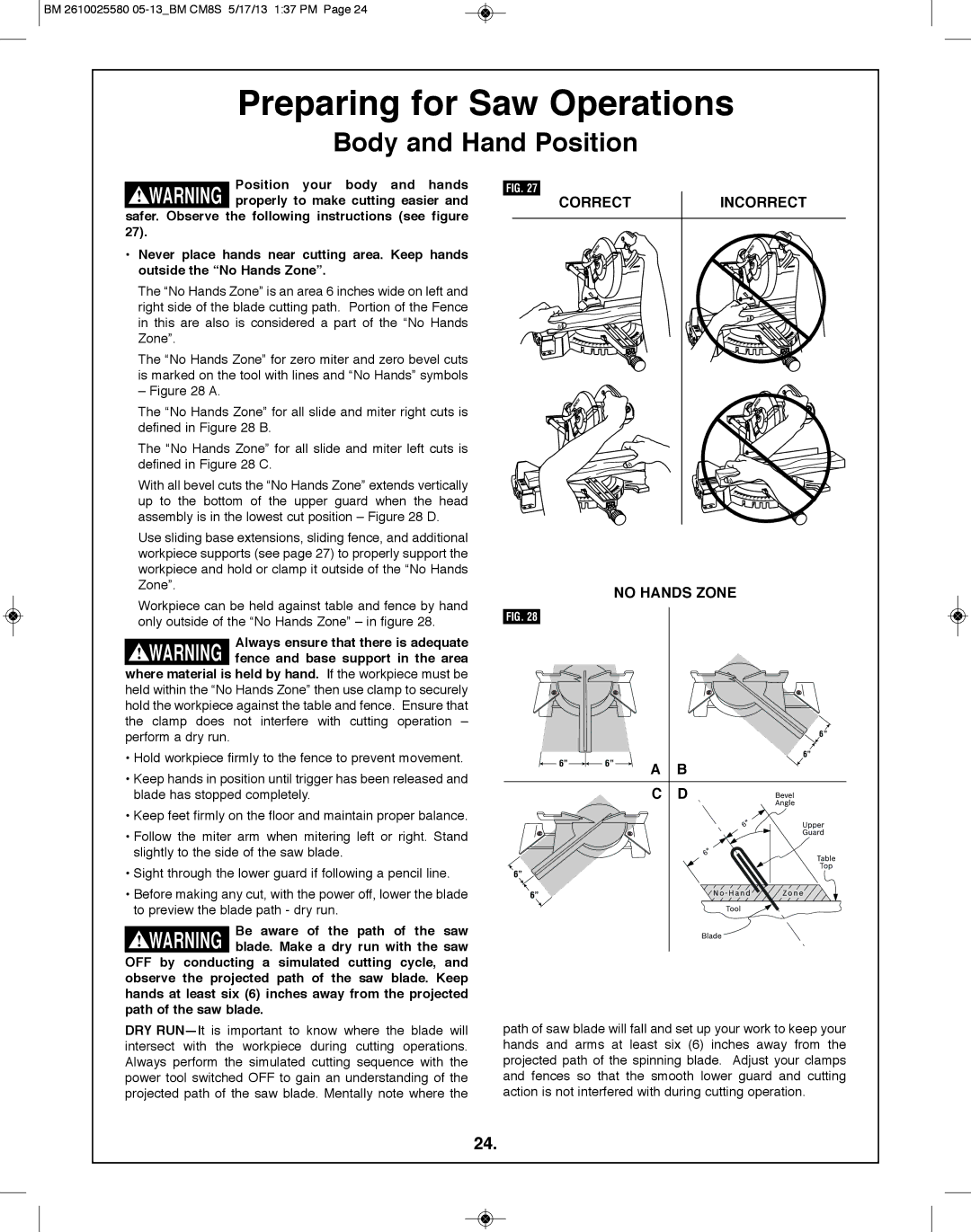
![]() BM 2610025580
BM 2610025580
preparing for Saw Operations
Body and Hand position
| position your body and hands | |
! WARNING | ||
properly to make cutting easier and |
safer. Observe the following instructions (see figure 27).
• Never place hands near cutting area. Keep hands outside the “No Hands zone”.
The “No Hands Zone” is an area 6 inches wide on left and right side of the blade cutting path. Portion of the Fence in this are also is considered a part of the “No Hands Zone”.
The “No Hands Zone” for zero miter and zero bevel cuts is marked on the tool with lines and “No Hands” symbols
– Figure 28 A.
The “No Hands Zone” for all slide and miter right cuts is defined in Figure 28 B.
The “No Hands Zone” for all slide and miter left cuts is defined in Figure 28 C.
With all bevel cuts the “No Hands Zone” extends vertically up to the bottom of the upper guard when the head assembly is in the lowest cut position – Figure 28 D.
Use sliding base extensions, sliding fence, and additional workpiece supports (see page 27) to properly support the workpiece and hold or clamp it outside of the “No Hands Zone”.
Workpiece can be held against table and fence by hand only outside of the “No Hands Zone” – in figure 28.
Always ensure that there is adequate ! WARNING fence and base support in the area
where material is held by hand. If the workpiece must be held within the “No Hands Zone” then use clamp to securely hold the workpiece against the table and fence. Ensure that the clamp does not interfere with cutting operation – perform a dry run.
• Hold workpiece firmly to the fence to prevent movement.
• Keep hands in position until trigger has been released and blade has stopped completely.
• Keep feet firmly on the floor and maintain proper balance.
• Follow the miter arm when mitering left or right. Stand slightly to the side of the saw blade.
• Sight through the lower guard if following a pencil line.
• Before making any cut, with the power off, lower the blade to preview the blade path - dry run.
Be aware of the path of the saw blade. Make a dry run with the saw Off by conducting a simulated cutting cycle, and
observe the projected path of the saw blade. Keep hands at least six (6) inches away from the projected path of the saw blade.
FIG. 27
CORRECT | INCORRECT | ||||||||
|
|
|
|
|
|
|
|
|
|
|
|
|
|
|
|
|
|
|
|
50 |
|
|
|
|
|
|
|
| 50 |
|
|
|
|
|
|
|
|
45 | 40 | 35 |
|
|
|
|
|
| 45 | 40 | 35 |
|
|
|
|
|
|
|
| 30 | 25 | 20 |
|
|
|
|
| 30 | 25 | 20 |
|
|
| ||
|
|
|
| 15 | 10 | 5 |
|
|
|
| 15 | 10 | 5 |
50 |
|
|
|
|
|
|
|
| 50 |
|
|
|
|
|
|
|
|
45 | 40 | 35 |
|
|
|
|
|
| 45 | 40 | 35 |
|
|
|
|
|
|
|
| 30 | 25 | 20 |
|
|
|
|
| 30 | 25 | 20 | 15 |
|
| ||
|
|
|
| 15 | 10 | 5 |
|
|
|
| 10 | 5 |
NO HANDS zONE
FIG. 28
6”
6” | 6” |
| 6” | |
A | B | |||
|
|
CD
6”
6”
path of saw blade will fall and set up your work to keep your hands and arms at least six (6) inches away from the projected path of the spinning blade. Adjust your clamps and fences so that the smooth lower guard and cutting action is not interfered with during cutting operation.
24.
